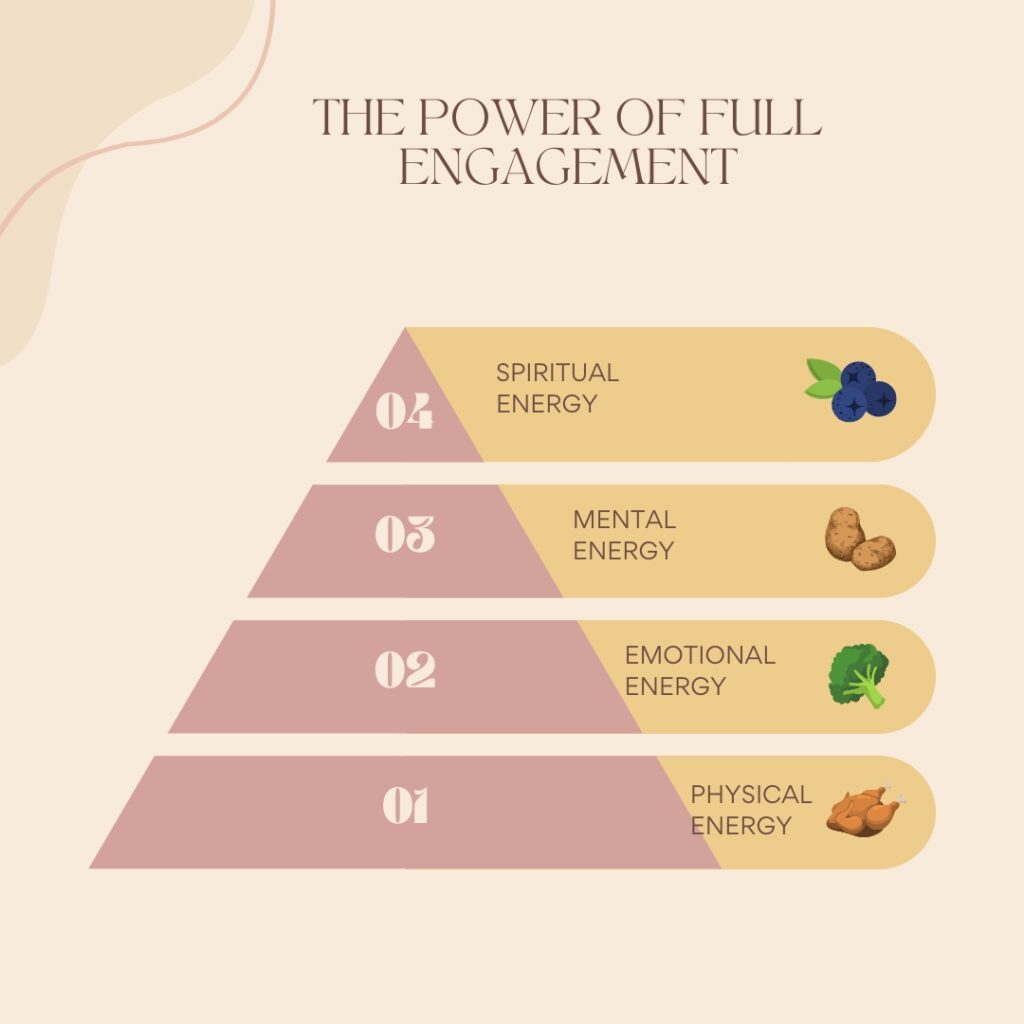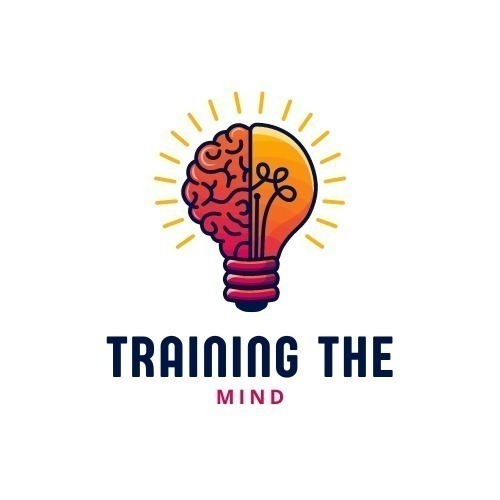The Power of Full Engagement: In a world that glorifies busyness and productivity, it’s easy to overlook the importance of managing our energy levels. We often find ourselves frantically chasing after more time, only to end up feeling drained and unfulfilled. But what if the key to success and true engagement lies not in managing time, but in managing our energy? That is the powerful message delivered by Jim Loehr and Tony Schwartz in their enlightening book, “The Power of Full Engagement.“
Loehr and Schwartz challenge the conventional wisdom that time management is the ultimate solution to maximizing productivity. Instead, they propose a groundbreaking concept: energy management. Drawing from their extensive research and work with top athletes and executives, the authors argue that energy, not time, is the true currency of high performance. By effectively managing our physical, emotional, mental, and spiritual energy, we can tap into our full potential and achieve a state of full engagement.
“The Power of Full Engagement” is not just another self-help book. It is a comprehensive guide that delves into the four principles of full engagement, the energy pyramid, and the importance of energy rituals. Through practical advice and thought-provoking insights, Loehr and Schwartz show us how to optimize our energy levels and create a sustainable path to success. By incorporating short breaks, practicing mindfulness, and aligning our activities with our values and purpose, we can experience a profound shift in our performance and overall well-being.
So, if you’re ready to break free from the never-ending cycle of exhaustion and unfulfillment, “The Power of Full Engagement” is a must-read. This book will not only transform the way you approach your work and personal life, but it will also empower you to unleash your full potential. Get ready to discover the power of energy management and embark on a journey towards a more engaged, balanced, and fulfilling life.
The Power of Full Engagement: Chapter Wise Summary
Chapter 1: The Power of Full Engagement
In the first chapter of “The Power of Full Engagement,” authors Jim Loehr and Tony Schwartz introduce us to the concept of energy management. They argue that managing our energy is even more important than managing our time. The authors explain that energy, not time, is the fundamental currency of high performance, and that to be truly engaged and successful, we must learn how to effectively manage our energy levels.
Loehr and Schwartz emphasize the significance of energy management by stating, “Energy, not time, is the fundamental currency of high performance.” They go on to explain that while time is finite and limited, our energy is renewable and can be expanded. By focusing on managing our energy, we can optimize our performance and achieve greater levels of success.
The authors highlight the importance of balancing our energy sources, including physical, emotional, mental, and spiritual energy. They argue that neglecting any of these sources can lead to imbalances and hinder our overall performance. For example, they mention a study conducted by the Harvard Business Review, which found that employees who experienced high levels of stress and burnout had a 50% higher healthcare cost compared to their peers who managed their energy effectively.
Loehr and Schwartz also introduce the concept of oscillation, which is the rhythmic movement between energy expenditure and recovery. They explain that just like a muscle, our energy capacity increases when we alternate between periods of intense focus and relaxation. They provide the example of top athletes who follow this principle by incorporating rest and recovery periods into their training routines. By adopting this approach, individuals can sustain high performance levels over the long term.
The authors illustrate the principle of oscillation with a story about the tennis player Andre Agassi. They describe how Agassi, known for his intense playing style, would take short breaks during matches to conserve and replenish his energy. This strategy allowed him to maintain a high level of performance throughout the entire match, even against opponents who relied solely on their physical abilities.
Furthermore, Loehr and Schwartz discuss the concept of the pulse, which refers to the regular and rhythmic renewal of energy. They suggest incorporating short breaks and recovery periods throughout the day to maintain a steady level of energy. They explain that these breaks can be as simple as taking a few minutes to stretch or practice deep breathing. By implementing these pulse rituals, individuals can prevent energy depletion and sustain their performance throughout the day.
To emphasize the importance of energy alignment, the authors share the story of a client named Laura, who was experiencing a lack of motivation and fulfillment in her career. Through coaching, Laura realized that her work was not aligned with her values and purpose. As a result, she felt drained and disengaged. Loehr and Schwartz argue that when our energy is aligned with what truly matters to us, we experience a deep sense of fulfillment and motivation.
Chapter 2: The Four Principles of Full Engagement

Loehr and Schwartz lay out the four principles of full engagement in this chapter. The first principle is that full engagement requires drawing on four separate but related sources of energy: physical, emotional, mental, and spiritual. The authors emphasize the importance of balancing these four energy sources in order to achieve optimal performance.
The second principle is the importance of oscillation, or the rhythmic movement between energy expenditure and recovery. They explain that like a muscle, our energy capacity increases when we alternate between periods of intense focus and relaxation.
The third principle is the idea of the pulse, which refers to the regular and rhythmic renewal of energy. The authors suggest incorporating short breaks and recovery periods throughout the day to maintain a steady level of energy.
The fourth principle is the concept of full engagement, which is characterized by the alignment of our energy with our values and purpose. The authors argue that when our energy is aligned with what truly matters to us, we experience a deep sense of fulfillment and motivation.
The first principle is the recognition that full engagement requires drawing on four separate but related sources of energy: physical, emotional, mental, and spiritual. The authors emphasize the importance of balancing these four energy sources to achieve optimal performance. They state, “Energy, not time, is the fundamental currency of high performance.”
To illustrate this principle, Loehr and Schwartz share the example of professional tennis player Monica Seles. Despite her immense talent and success, Seles experienced a decline in performance due to neglecting her emotional energy. By addressing her emotional well-being and finding ways to recharge emotionally, Seles was able to regain her full engagement and elevate her performance.
The second principle introduced is the concept of oscillation, which refers to the rhythmic movement between energy expenditure and recovery. Just as a muscle grows stronger during recovery periods after intense exercise, our energy capacity increases when we alternate between periods of intense focus and relaxation. The authors highlight the importance of creating regular breaks and recovery periods to maintain optimal energy levels.
To support this principle, Loehr and Schwartz cite a study conducted by the U.S. Army. They found that soldiers who took regular breaks during training had significantly higher levels of engagement and performed better than those who pushed through without breaks. This study demonstrates the significance of oscillation in maintaining high levels of performance.
The third principle is the idea of the pulse, which refers to the regular and rhythmic renewal of energy. The authors suggest incorporating short breaks and recovery periods throughout the day to maintain a steady level of energy. They state, “To sustain full engagement, we must take care of our bodies in a way that ensures the energy pulse remains strong and regular.”
To illustrate the importance of the pulse, Loehr and Schwartz discuss the case of a financial analyst named Mark. Mark experienced burnout and a decline in performance due to working long hours without breaks. By implementing regular breaks and recovery periods, Mark was able to restore his energy levels and regain his full engagement at work.
The fourth principle introduced is the concept of full engagement, which is characterized by the alignment of our energy with our values and purpose. The authors argue that when our energy is aligned with what truly matters to us, we experience a deep sense of fulfillment and motivation.
To support this principle, Loehr and Schwartz share the story of an executive named Helen. Helen was successful in her career but felt a lack of purpose and fulfillment. By reflecting on her values and aligning her energy with her true purpose, Helen was able to reignite her passion and find a renewed sense of engagement and fulfillment in her work.
Chapter 3: The Energy Pyramid
Loehr and Schwartz introduce the concept of the energy pyramid in this chapter. They explain that just as a pyramid is built from a strong foundation, our energy levels must be built from a foundation of physical energy. The authors emphasize the importance of taking care of our physical well-being by getting enough sleep, eating nutritious food, and exercising regularly.
They also discuss the importance of emotional energy, which is closely tied to our relationships and the quality of our interactions with others. Mental energy, which is the ability to focus and concentrate, is another key component of the energy pyramid. Lastly, the authors touch on spiritual energy, which involves connecting with our values and purpose.
Loehr and Schwartz state, “Physical energy is the fundamental source of fuel that we draw on to fuel all our activities and interactions“. They argue that neglecting our physical energy can have detrimental effects on our overall performance and well-being. They provide several examples of how physical energy impacts our daily lives, such as feeling lethargic and unmotivated when we are sleep-deprived or lacking proper nutrition.
The authors also highlight the significance of emotional energy, which is closely tied to our relationships and the quality of our interactions with others. They state, “Emotional energy is the energy of connection and caring” . Loehr and Schwartz explain that when we are emotionally drained or have unresolved conflicts in our relationships, it can significantly deplete our energy levels and hinder our ability to perform at our best.
Mental energy, the ability to focus and concentrate, is another key component of the energy pyramid. The authors assert, “Mental energy is the energy of focus and concentration“. They discuss how distractions, multitasking, and constant mental stimulation can drain our mental energy, making it difficult to stay focused and perform tasks effectively. Loehr and Schwartz suggest implementing strategies such as setting clear priorities, managing distractions, and incorporating regular breaks to maintain optimal mental energy.
Lastly, the authors touch on spiritual energy, which involves connecting with our values and purpose. They state, “Spiritual energy is the energy of meaning and purpose“. Loehr and Schwartz argue that when our activities align with our values and purpose, we experience a deep sense of fulfillment and motivation. They provide examples of individuals who have tapped into their spiritual energy by engaging in activities that align with their passions and values, resulting in increased energy and productivity.

Chapter 4: The Energy Rituals

In this chapter, Loehr and Schwartz introduce the concept of energy rituals, which are specific practices that help us manage our energy levels. They argue that rituals are more effective than relying solely on willpower, as they provide structure and consistency.
The authors suggest creating rituals for each of the four energy dimensions: physical, emotional, mental, and spiritual. For example, a physical energy ritual could be taking a short walk or stretching every hour. An emotional energy ritual could involve expressing gratitude or journaling. Mental energy rituals could include setting aside specific times for focused work or incorporating regular breaks. Lastly, spiritual energy rituals could involve meditation or reflecting on personal values.
The authors begin by explaining that energy rituals are specific practices that we can incorporate into our daily lives to optimize our energy levels. These rituals can be categorized into four dimensions: physical, emotional, mental, and spiritual.
For physical energy, Loehr and Schwartz suggest creating rituals that focus on taking care of our bodies. They quote a study where participants who took short walks during the day experienced a significant increase in energy and focus. The authors highlight the importance of incorporating movement and exercise into our routines to enhance our physical energy.
In terms of emotional energy, the authors suggest rituals that help us manage and replenish our emotions. They mention the power of expressing gratitude as an emotional energy ritual. By taking a few moments each day to reflect on what we are grateful for, we can shift our focus towards positivity and increase our emotional well-being.
When it comes to mental energy, Loehr and Schwartz emphasize the need for rituals that promote focus and concentration. They mention the example of setting aside specific times for focused work, free from distractions. By creating a ritual of uninterrupted work periods, we can enhance our mental energy and productivity.
Lastly, the authors discuss spiritual energy and the importance of rituals that connect us with our values and purpose. They mention the example of meditation as a powerful spiritual energy ritual. By taking time to quiet our minds and reflect on our values and purpose, we can cultivate a sense of inner peace and alignment.
Loehr and Schwartz highlight that the key to effective energy rituals is consistency. They suggest incorporating these rituals into our daily routines and making them a non-negotiable part of our lives. The authors emphasize that by consistently practicing energy rituals, we can enhance our overall energy levels and performance.
Chapter 5: Training the Mind

Loehr and Schwartz discuss the importance of training the mind in this chapter. They argue that our thoughts and beliefs greatly impact our energy levels and performance. The authors introduce the concept of positive energy rituals, which involve replacing negative thoughts with positive ones.
They also discuss the role of self-awareness in energy management. By paying attention to our thoughts and emotions, we can identify patterns and triggers that drain our energy. The authors suggest practicing mindfulness and meditation as tools for developing self-awareness.
The authors introduce the concept of positive energy rituals, which involve replacing negative thoughts with positive ones. They explain that our thoughts have a direct influence on our emotions and energy levels. Loehr and Schwartz state, “Negative thoughts drain energy, while positive thoughts fuel energy“. They suggest implementing specific mental routines to interrupt negative thought patterns and replace them with more constructive and empowering thoughts.
To illustrate the power of positive energy rituals, the authors share the story of golfer Jack Nicklaus. Despite facing challenges and setbacks, Nicklaus maintained a positive mindset by using specific mental rituals. He would visualize his successful shots, repeat positive affirmations, and focus on his strengths rather than dwelling on mistakes. This mental training allowed him to stay resilient and perform at his best even under pressure.
Loehr and Schwartz also discuss the role of self-awareness in energy management. They explain that by paying attention to our thoughts and emotions, we can identify patterns and triggers that drain our energy. The authors state, “Self-awareness is the first step toward change, and it is the foundation for self-control“.
To develop self-awareness, the authors suggest practicing mindfulness and meditation. These techniques help us observe our thoughts and emotions without judgment, allowing us to gain insight into our energy patterns. They provide an example of a study conducted with executive coaching clients who practiced mindfulness for just ten minutes a day. The participants reported increased self-awareness, improved focus, and better stress management.
Furthermore, Loehr and Schwartz highlight the importance of reframing our thoughts to enhance our mental energy. They explain that by consciously choosing to interpret situations in a positive and empowering way, we can shift our energy levels. The authors state, “Reframing is a mental exercise that enables us to turn negative experiences into positive ones by changing our perception of reality“.
An example they provide is that of a corporate executive who faced a challenging situation at work. Instead of viewing it as a failure, he reframed it as a learning opportunity and focused on the lessons he gained from the experience. This positive mindset allowed him to bounce back quickly and maintain high levels of mental energy.
Chapter 6: The Power of Purpose
In the final chapter, Loehr and Schwartz explore the concept of purpose and its impact on energy management. They argue that having a clear sense of purpose provides us with a strong motivation and sense of direction.
The authors suggest reflecting on our values and what truly matters to us in order to discover our purpose. They also emphasize the importance of aligning our daily activities with our purpose, as this leads to a deeper sense of fulfillment and engagement.
Loehr and Schwartz emphasize that purpose is not just a lofty ideal, but something that can be grounded in everyday actions. They state, “Purpose is the foundation of any significant accomplishment. It has to do with our deepest desires, values, and hopes. It is our sense of why we are here and what we are meant to do with our lives“.
The authors suggest that aligning our daily activities with our purpose is crucial for experiencing a deep sense of fulfillment and engagement. They give an example of a CEO named Rick, who was initially driven by external markers of success but eventually realized that his true purpose was to create a positive work environment for his employees. Once he aligned his actions with this purpose, he felt more energized and motivated.
Loehr and Schwartz also emphasize that purpose can evolve and change over time. They write, “Purpose is not a fixed destination, but rather a journey that unfolds throughout our lives. It is a reflection of our deepest yearnings and aspirations, and it changes as we grow and evolve“.
To help readers discover their purpose, the authors provide a series of reflective questions and exercises. They encourage readers to consider their values, passions, and the impact they want to make in the world. By exploring these aspects, individuals can gain clarity on their purpose and make choices that align with it.
One of the key takeaways from this chapter is the importance of integrating purpose into our daily lives. Loehr and Schwartz state, “Without daily rituals and practices that connect us to our purpose, it is easy to lose sight of what is truly important to us“. They suggest incorporating purpose-related rituals, such as writing in a gratitude journal or spending time in nature, to stay connected to our deeper motivations.
In conclusion, “The Power of Full Engagement” by Jim Loehr and Tony Schwartz offers valuable insights and practical strategies for effectively managing our energy levels. By implementing the principles of full engagement and incorporating energy rituals into our daily lives, we can achieve higher levels of performance and fulfillment
Samrat is a Delhi-based MBA from the Indian Institute of Management. He is a Strategy, AI, and Marketing Enthusiast and passionately writes about core and emerging topics in Management studies. Reach out to his LinkedIn for a discussion or follow his Quora Page

